Comparative Anti-Cancer and Anti-Inflammatory Activities of Essential Oils from the Bark and Flower of Magnolia officinalis Rehd. et Wils
Abstract
1. Introduction
2. Materials and Methods
2.1. Plant Materials
2.2. Extraction of Essential Oil
2.2.1. SD Method
2.2.2. SDE Method
2.3. GC–MS Analysis
2.4. Antioxidant Activity
2.4.1. Reducing Power assay
2.4.2. DPPH• Radical Scavenging Activity Assay
2.4.3. ABTS•+ Radical Scavenging Activity Assay
2.4.4. FRAP Assay
2.4.5. •OH Scavenging Activity Assay
2.5. Cell Culture
2.6. MTT Assay
2.7. Determination of NO, IL-6 and TNF-α by ELISA in RAW264.7 Cells
2.8. RT-qPCR Analysis
2.9. Statistical Analysis
3. Results and Discussion
3.1. Comparative Analysis of Essential Oil Compounds
3.2. Antioxidant Activity
3.3. Anti-Tumor Activity
3.4. Anti-Inflammatory Activity
3.4.1. Effect of EOs on LPS-Induced NO and iNOS in RAW 264.7 Cells
3.4.2. Effect of EOs on LPS-Induced IL-6 and TNF-α in RAW 264.7 Cells
4. Conclusions
Author Contributions
Funding
Institutional Review Board Statement
Informed Consent Statement
Data Availability Statement
Conflicts of Interest
Abbreviations
References
- Wu, Q.H.; Wei, D.; Dong, L.L.; Liu, Y.P.; Ren, C.X.; Liu, Q.Q.; Chen, C.P.; Chen, J.; Pei, J. Variation in the microbial community contributes to the improvement of the main active compounds of Magnolia officinalis Rehd. et Wils in the process of sweating. Chin. Med.-UK 2019, 14, 45. [Google Scholar] [CrossRef] [PubMed]
- Pang, Y.L.; Han, X.F.; Bamikole, M.A.; Gong, Z.H.; Tang, S.X.; Tan, Z.L.; Xiao, W.J.; Zhou, C.S.; Wang, M.; Deng, Y.L. Anti-diarrhea and anti-oxidant properties of Magnolol. Trop. J. Pharm. Res. 2013, 12, 85–91. [Google Scholar] [CrossRef]
- Xing, H.; Zhang, K.; Zhang, R.W.; Shi, H.Y.; Bi, K.S.; Chen, X.H. Antidepressant-like effect of the water extract of the fixed combination of Gardenia jasminoides, Citrus aurantium and Magnolia officinalis in a rat model of chronic unpredictable mild stress. Phytomedicine 2015, 22, 1178–1185. [Google Scholar] [CrossRef] [PubMed]
- Kim, J.Y.; Kim, K.H.; Kwag, E.H.; Seol, Y.J.; Lee, Y.M.; Ku, Y.; Rhyu, I.C. Magnoliae Cortex and maize modulate Porphyromonas gingivalis-induced Inflammatory reactions. J. Periodontal Impla. 2018, 48, 70–83. [Google Scholar] [CrossRef] [PubMed]
- Liao, H.R.; Chien, C.R.; Chen, J.J.; Lee, T.Y.; Lin, S.Z.; Tseng, C.P. The anti-inflammatory effect of 2-(4-hydroxy-3-prop-2-enyl-phenyl)-4-prop-2-enyl-phenol by targeting Lyn kinase in human neutrophils. Chem.-Biol. Interac. 2015, 236, 90–101. [Google Scholar] [CrossRef] [PubMed]
- Wu, W.W.; Xue, W. Evaluation of anticancer activity of honokiol by complexation with hydroxypropyl-β-cyclodextrin. Colloid. Surf. B 2020, 196, 111298. [Google Scholar] [CrossRef] [PubMed]
- Fei, H.Q.; Li, M.X.; Liu, W.J.; Sun, L.; Li, N.; Cao, L.; Meng, Z.Q.; Huang, W.Z.; Ding, G.; Wang, Z.Z.; et al. Potential lipase inhibitors from Chinese medicinal herbs. Pharm. Biol. 2016, 54, 2845–2850. [Google Scholar] [CrossRef] [PubMed]
- Wang, F.; Miao, M.B.; Xia, H.; Yang, L.G.; Wang, S.K.; Sun, G.J. Antioxidant activities of aqueous extracts from 12 Chinese edible flowers in vitro and in vivo. Food Nutr. Res. 2017, 61, 1265324. [Google Scholar] [CrossRef] [PubMed]
- Chen, X.H.; Hu, Y.; Shan, L.P.; Yu, X.B.; Hao, K.; Wang, G.X. Magnolol and honokiol from Magnolia officinalis enhanced antiviral immune responses against grass carp reovirus in Ctenopharyngodon idella kidney cells. Fish Shellfish. Immunol. 2017, 63, 245–254. [Google Scholar] [CrossRef]
- Huang, Y.; Liu, C.M.; Liu, S.; Liu, Z.Q.; Li, S.N.; Wang, Y.Q. In vitro metabolism of magnolol and honokiol in rat liver microsomes and their interactions with seven cytochrome P substrates. Rapid Commun. Mass Spectrom. 2019, 33, 229–238. [Google Scholar] [CrossRef] [PubMed]
- Horváth, G.; Horváth, A.; Reichert, G.; Böszörményi, A.; Sipos, K.; Pandur, E. Three chemotypes of thyme (Thymus vulgaris) essential oil and their main compounds affect differently the IL-6 and TNFα cytokine secretions of BV-2 microglia by modulating the NF-κB and C/EBPβ signalling pathways. BMC Complement. Med. Ther. 2021, 21, 148. [Google Scholar] [CrossRef] [PubMed]
- Liao, J.M.; Xie, X.Y.; Wang, W.L.; Gao, Y.; Cai, Y.L.; Peng, J.C.; Li, T.Z.; Yi, Q.; He, C.L.; Wang, L. Anti-inflammatory Activity of Essential Oil from Leaves of Blumea balsamifera (L.) DC through Inhibiting TLR4/NF-kB Signaling Pathways and NLRP3 Inflammasome Activation in LPS-induced RAW264.7 Macrophage Cells. J. Essent.Oil Bear. Plants 2021, 24, 160–176. [Google Scholar] [CrossRef]
- Peng, X.J.; Feng, C.T.; Wang, X.; Gu, H.Y.; Li, J.L.; Zhang, X.N.; Zhang, X.C.; Yang, L. Chemical composition and antioxidant activity of essential oils from barks of Pinus pumila using microwave-assisted hydrodistillation after screw extrusion treatment. Ind. Crops Prod. 2021, 166, 113489. [Google Scholar] [CrossRef]
- Rombolà, L.; Scuteri, D.; Watanabe, C.; Sakurada, S.; Hamamura, K.; Sakurada, T.; Tonin, P.; Corasaniti, M.T.; Bagetta, G.; Morrone, L.A. Role of 5-HT1A Receptor in the Anxiolytic-Relaxant Effects of Bergamot Essential Oil in Rodent. Int. J. Mol. Sci. 2020, 21, 2597. [Google Scholar] [CrossRef] [PubMed]
- Zhang, K.; Lu, J.; Yao, L. Involvement of the dopamine D1 receptor system in the anxiolytic effect of cedrol in the elevated plus maze and light-dark box tests. J. Pharmacol. Sci. 2020, 142, 26–33. [Google Scholar] [CrossRef] [PubMed]
- Liu, M.T.; Luo, F.Y.; Qing, Z.X.; Yang, H.C.; Liu, X.B.; Yang, Z.H.; Zeng, J.G. Chemical Composition and Bioactivity of Essential Oil of Ten Labiatae Species. Molecules 2020, 25, 4862. [Google Scholar] [CrossRef] [PubMed]
- Suresh, A.; Velusamy, S.; Ayyasamy, S.; Rathinasamy, M. Techniques for essential oil extraction from kaffir lime and its application in health care products-A review. Flavour Fragr. J. 2021, 36, 5–21. [Google Scholar] [CrossRef]
- Zhang, J.X.; Wen, C.T.; Zhang, H.H.; Duan, Y.Q.; Ma, H.L. Recent advances in the extraction of bioactive compounds with subcritical water: A review. Trends Food Sci. Technol. 2020, 95, 183–195. [Google Scholar] [CrossRef]
- Zhu, J.-J.; Yang, J.-J.; Wu, G.-J.; Jiang, J.-G. Comparative antioxidant, anticancer and antimicrobial activities of essential oils from Semen Platycladi by different extraction methods. Ind. Crops Prod. 2020, 146, 112206. [Google Scholar] [CrossRef]
- da Silva, R.; Rocha-Santos, T.A.P.; Duarte, A.C. Supercritical fluid extraction of bioactive compounds. TrAC Trends Anal. Chem. 2016, 76, 40–51. [Google Scholar] [CrossRef]
- Tohidi, B.; Rahimmalek, M.; Arzani, A. Essential oil composition, total phenolic, flavonoid contents, and antioxidant activity of Thymus species collected from different regions of Iran. Food Chem. 2017, 220, 153–161. [Google Scholar] [CrossRef] [PubMed]
- Iqbal, S.; Bhanger, M.I.; Anwar, F. Antioxidant properties and components of some commercially available varieties of rice bran in Pakistan. Food Chem. 2005, 93, 265–272. [Google Scholar] [CrossRef]
- Villaño, D.; Fernández-Pachón, M.S.; Moyá, M.L.; Troncoso, A.M.; García-Parrilla, M.C. Radical scavenging ability of polyphenolic compounds towards DPPH free radical. Talanta 2007, 71, 230–235. [Google Scholar] [CrossRef]
- Hou, M.Y.; Hu, W.Z.; Wang, A.S.; Xiu, Z.L.; Shi, Y.S.; Hao, K.X.; Sun, X.S.; Cao, D.; Lu, R.S.; Sun, J. Ultrasound-Assisted Extraction of Total Flavonoids from Pteris cretica L.: Process Optimization, HPLC Analysis, and Evaluation of Antioxidant Activity. Antioxidants 2019, 8, 425. [Google Scholar] [CrossRef] [PubMed]
- Benzie, I.F.; Strain, J.J. The ferric reducing ability of plasma (FRAP) as a measure of “antioxidant power”: The FRAP assay. Anal. Biochem. 1996, 239, 70–76. [Google Scholar] [CrossRef] [PubMed]
- Hao, K.X.; Hu, W.Z.; Hou, M.Y.; Cao, D.; Wang, Y.; Guan, Q.X.; Zhang, X.F.; Wang, A.S.; Yu, J.X.; Guo, B.M. Optimization of Ultrasonic-Assisted Extraction of Total Phenolics from Citrus aurantium L. Blossoms and Evaluation of Free Radical Scavenging, Anti-HMG-CoA Reductase Activities. Molecules 2019, 24, 2368. [Google Scholar] [CrossRef] [PubMed]
- Shen, C.Y.; Zhang, W.L.; Jiang, J.G. Immune-enhancing activity of polysaccharides from Hibiscus sabdariffa Linn. via MAPK and NF-κB signaling pathways in RAW264.7 cells. J. Funct. Foods 2017, 34, 118–129. [Google Scholar] [CrossRef]
- Csóka, M.; Amtmann, M. Comparing different extraction methods for the investigation of red pepper (Capsicum annuum L.) volatiles. J. Essent. Oil Res. 2021, 33, 189–196. [Google Scholar] [CrossRef]
- Hadidi, M.; Pouramin, S.; Adinepour, F.; Haghani, S.; Jafari, S.M. Chitosan nanoparticles loaded with clove essential oil: Characterization, antioxidant and antibacterial activities. Carbohydr. Polym. 2020, 236, 116075. [Google Scholar] [CrossRef] [PubMed]
- Moody, R.; Wilson, K.; Jaworowski, A.; Plebanski, M. Natural Compounds with Potential to Modulate Cancer Therapies and Self-Reactive Immune Cells. Cancers 2020, 12, 673. [Google Scholar] [CrossRef] [PubMed]
- Prakash, O.; Supriya, A.; Kudachikar, V.B. Physicochemical Changes, Phenolic Profile and Antioxidant Capacities of Colored and White Grape (Vitis Vinifera L.) Varieties during Berry Development and Maturity. Int. J. Fruit. Sci. 2020, 20, S1773–S1783. [Google Scholar] [CrossRef]
- Di Martile, M.; Garzoli, S.; Sabatino, M.; Valentini, E.; D‘Aguanno, S.; Ragno, R.; Del Bufalo, D. Antitumor effect of Melaleuca alternifolia essential oil and its main component terpinen-4-ol in combination with target therapy in melanoma models. Cell Death Discov. 2021, 7, 127. [Google Scholar] [CrossRef] [PubMed]
- Najar, B.; Shortrede, J.E.; Pistelli, L.; Buhagiar, J. Chemical Composition and in Vitro Cytotoxic Screening of Sixteen Commercial Essential Oils on Five Cancer Cell Lines. Chem. Biodivers. 2020, 17, e1900478. [Google Scholar] [CrossRef] [PubMed]
- Spyridopoulou, K.; Aravidou, T.; Lampri, E.; Effraimidou, E.; Pappa, A.; Chlichlia, K. Antitumor Potential of Lippia citriodora Essential Oil in Breast Tumor-Bearing Mice. Antioxidants 2021, 10, 875. [Google Scholar] [CrossRef] [PubMed]
- Kaji, I.; Tatsuta, M.; Iishi, H.; Baba, M.; Inoue, A.; Kasugai, H. Inhibition by D-limonene of experimental hepatocarcinogenesis is in Sprague-Dawley rats does not involve p21(RAS) plasma membrane association. Int. J. Cancer 2001, 93, 441–444. [Google Scholar] [CrossRef] [PubMed]
- Parija, T.; Das, B.R. Involvement of YY1 and its correlation with c-myc in NDEA induced hepatocarcinogenesis, its prevention by d-limonene. Mol. Biol. Rep. 2003, 30, 41–46. [Google Scholar] [CrossRef] [PubMed]
- Talib, W.H. Consumption of garlic and lemon aqueous extracts combination reduces tumor burden by angiogenesis inhibition, apoptosis induction, and immune system modulation. Nutrition 2017, 43–44, 89–97. [Google Scholar] [CrossRef] [PubMed]
- Greten, F.R.; Grivennikov, S.I. Inflammation and Cancer: Triggers, Mechanisms, and Consequences. Immunity 2019, 51, 27–41. [Google Scholar] [CrossRef] [PubMed]
- Zhang, F.; Wei, K.; Slowikowski, K.; Fonseka, C.Y.; Rao, D.A.; Kelly, S.; Goodman, S.M.; Tabechian, D.; Hughes, L.B.; Salomon-Escoto, K.; et al. Defining inflammatory cell states in rheumatoid arthritis joint synovial tissues by integrating single-cell transcriptomics and mass cytometry. Nat. Immunol. 2019, 20, 928–942. [Google Scholar] [CrossRef] [PubMed]
- Zhang, J.; Ma, C.A.R.; Hua, Y.Q.; Li, L.; Ni, J.Y.; Huang, Y.T.; Duncan, S.E.; Li, S.; Gao, S.; Fan, G.W. Contradictory regulation of macrophages on atherosclerosis based on polarization, death and autophagy. Life Sci. 2021, 276, 118957. [Google Scholar] [CrossRef] [PubMed]
- Lee, J.J.; Kim, K.H.; Kim, E.J.; Choi, J.Y.; Kim, S.J.; Jeong, S.I.; Kim, J.I.; Joo, M. Anti-inflammatory activity of the decoction of Forsythia suspensa (Thunb.) Vahl is related to Nrf2 and A20. J. Ethnopharmacol. 2018, 227, 97–104. [Google Scholar] [CrossRef] [PubMed]
- Chen, J.L.; Tang, C.L.; Zhou, Y.; Zhang, R.F.; Ye, S.X.; Zhao, Z.M.; Lin, L.G.; Yang, D.P. Anti-Inflammatory Property of the Essential Oil from Cinnamomum camphora (Linn.) Presl Leaves and the Evaluation of Its Underlying Mechanism by Using Metabolomics Analysis. Molecules 2020, 25, 4796. [Google Scholar] [CrossRef] [PubMed]
- Lee, J.; Yang, G.; Lee, K.; Lee, M.H.; Eom, J.W.; Ham, I.; Choi, H.Y. Anti-inflammatory effect of Prunus yedoensis through inhibition of nuclear factor-κB in macrophages. BMC Complement. Altern. Med. 2013, 13, 92. [Google Scholar] [CrossRef]
- Liu, Z.N.; Jiang, T.; Wang, X.Z.; Wang, Y.X. Fluocinolone acetonide partially restores the mineralization of LPS-stimulated dental pulp cells through inhibition of NF-κB pathway and activation of AP-1 pathway. Br. J. Pharmacol. 2013, 170, 1262–1271. [Google Scholar] [CrossRef] [PubMed]

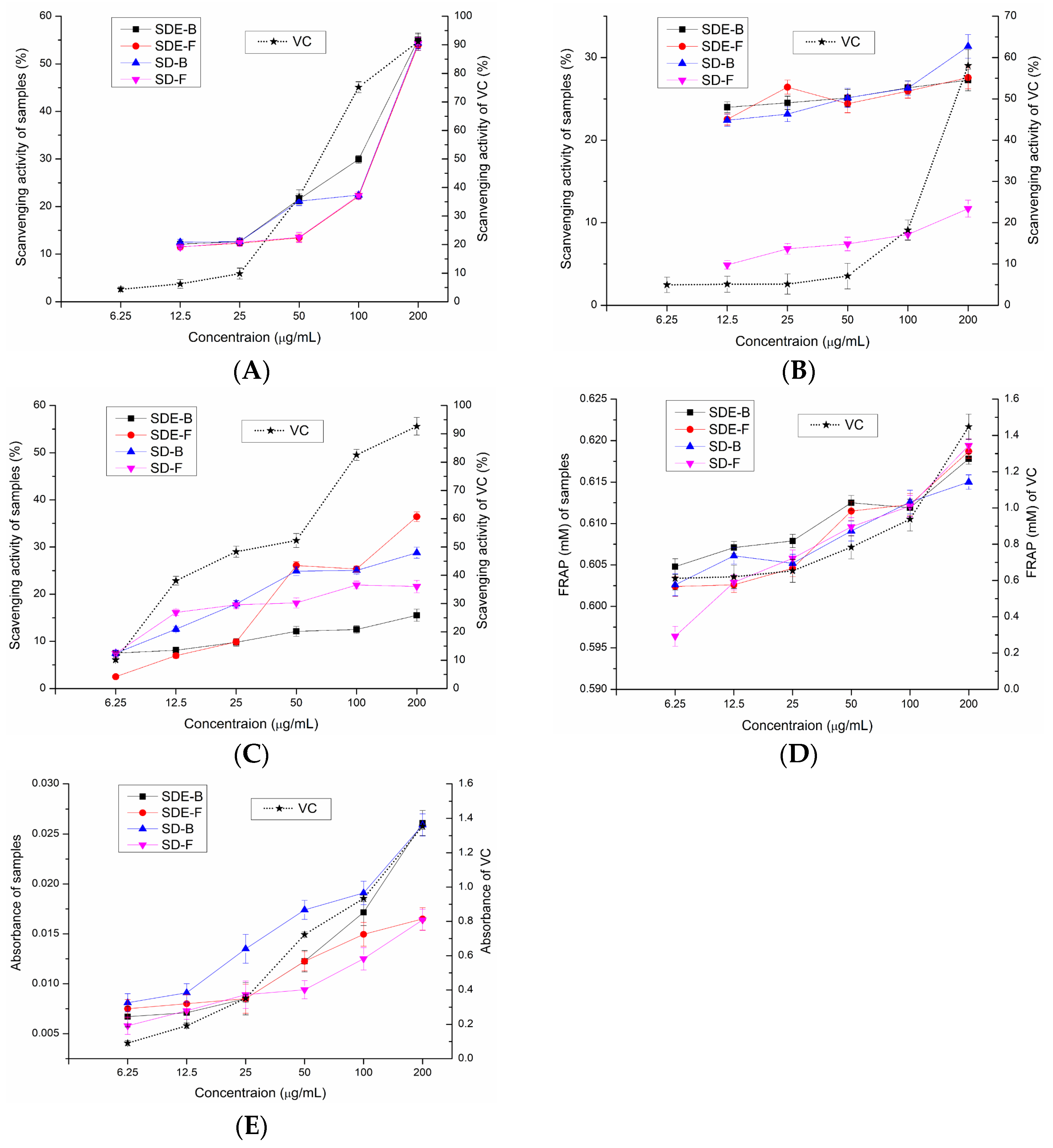
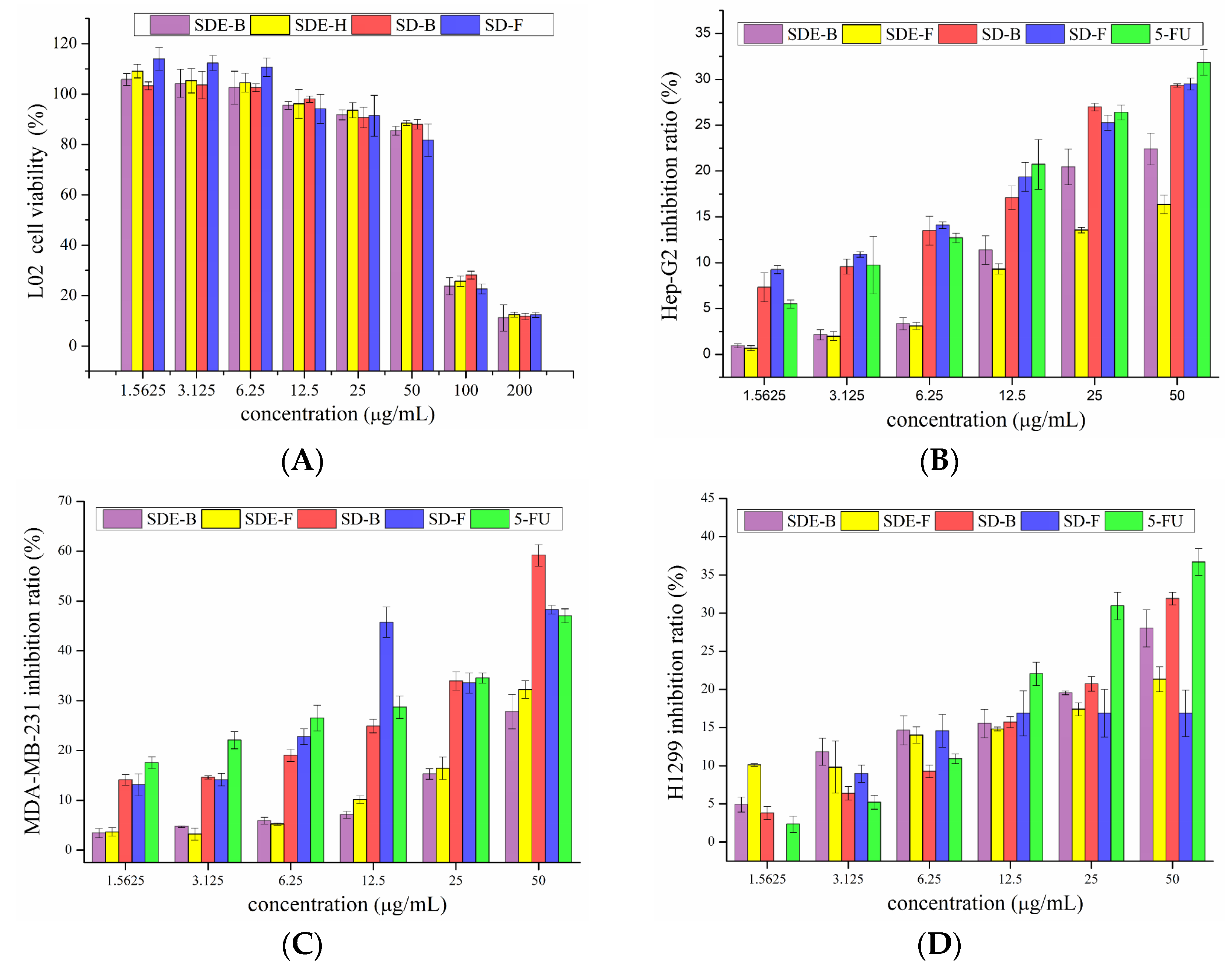
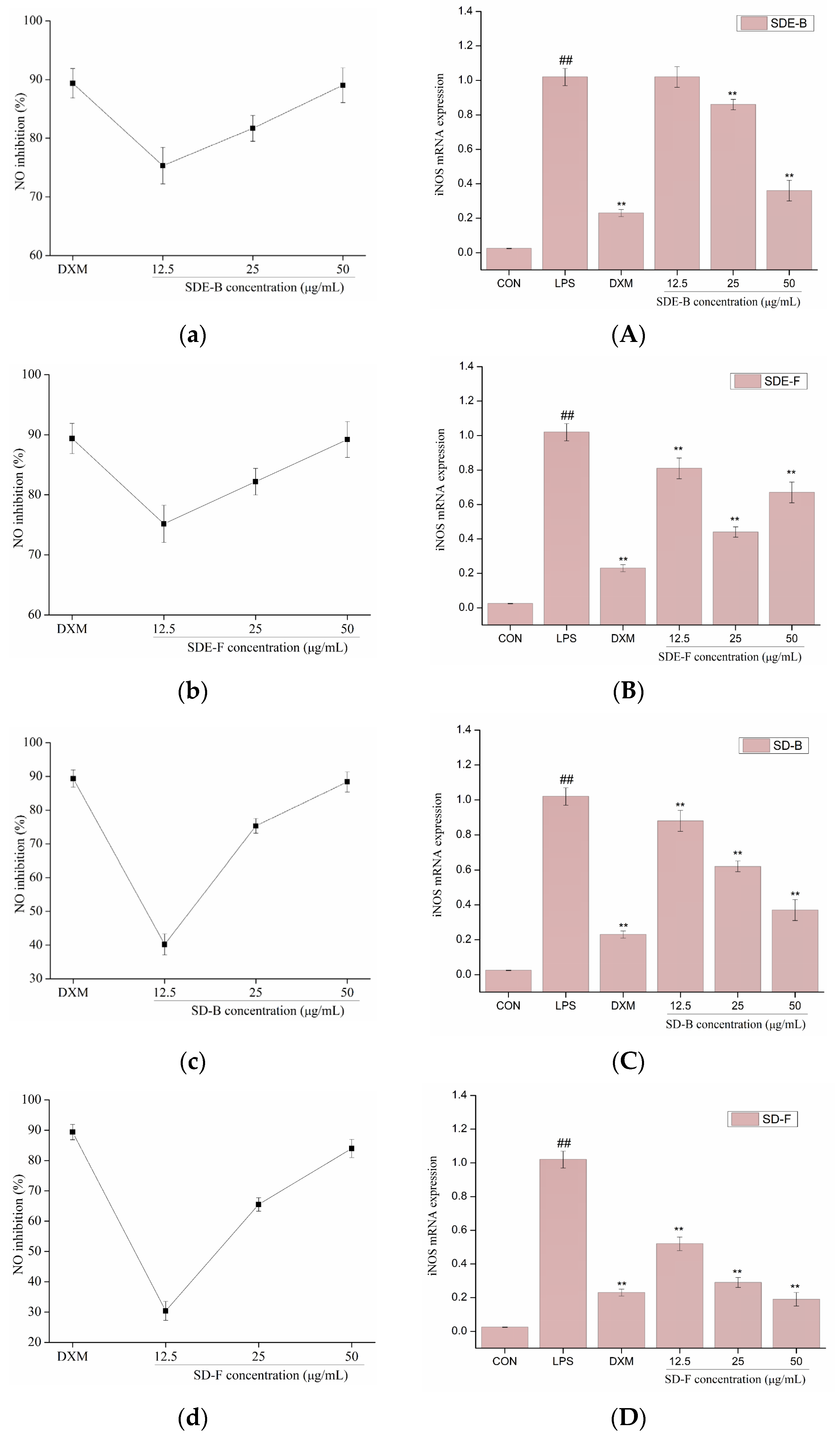
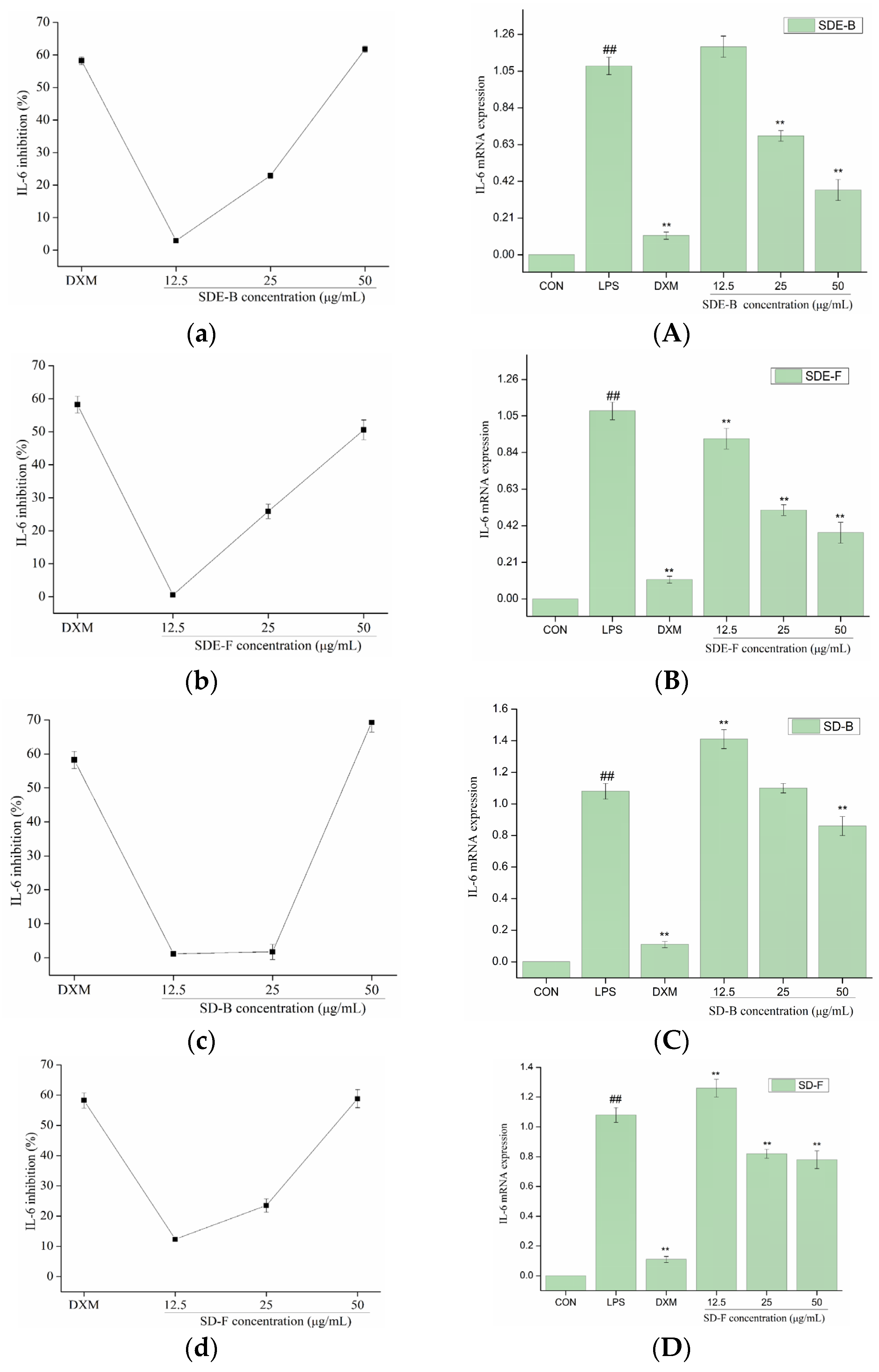
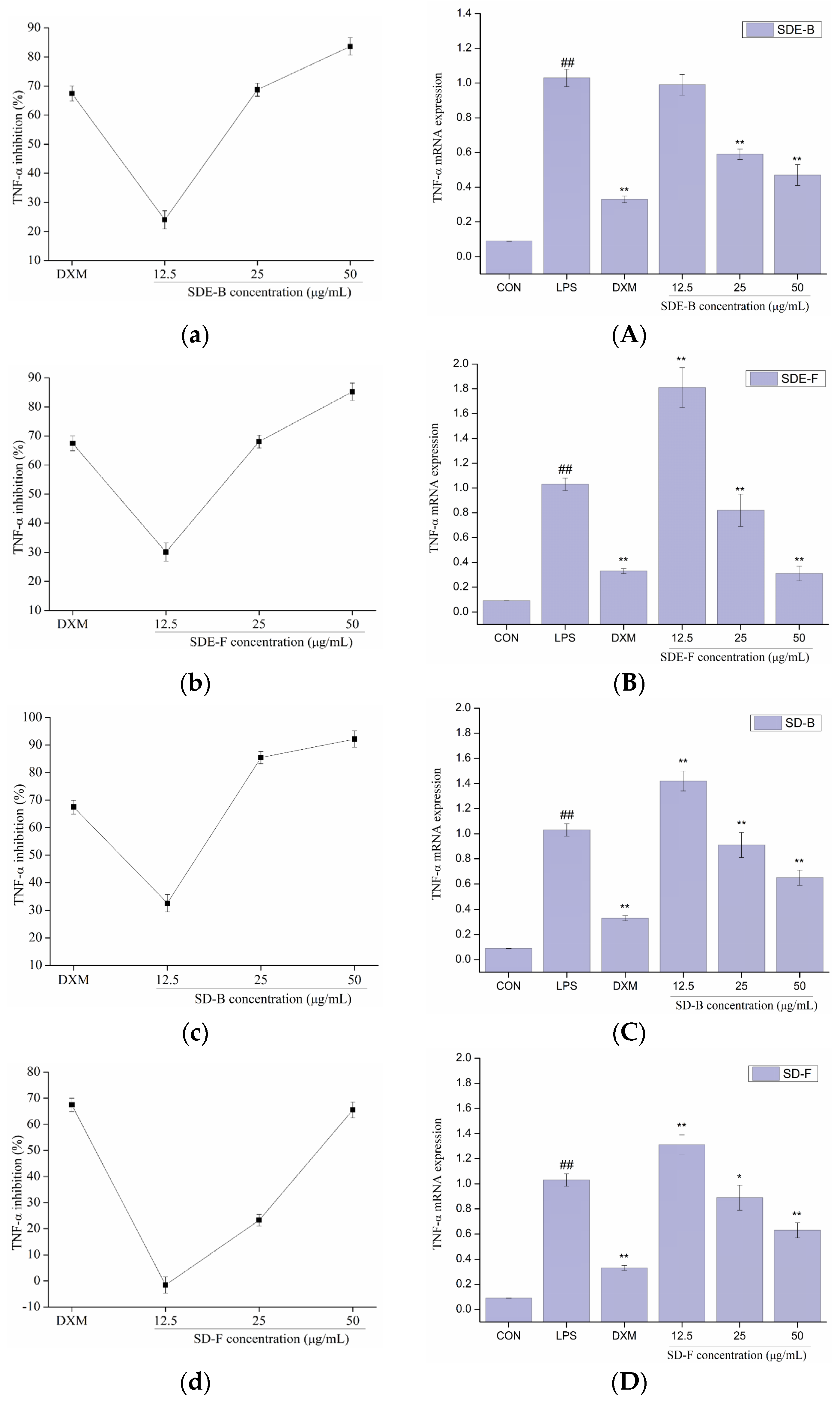
| Retention Time | Compound | CAS nr | Molecular Formula | Molecular Weight | Relative Percent Content/% | |||
|---|---|---|---|---|---|---|---|---|
| SDE-F | SDE-B | SD-F | SD-B | |||||
| 3.943 | 9,12-Octadecadienoyl chloride, (Z,Z)- | 1509-85-9 | C18H31O2 | 279.4375 | - a | 0.28 | 0.84 | 0.13 |
| 3.122 | Z-(13,14-Epoxy) tetradec-11-en-1-ol acetate | - | C16H28O3 | 268.3917 | - | 7.37 | 5.49 | 12.35 |
| 4.842 | 1R-α-Pinene | 7785-70-8 | C10H16 | 136.2340 | 2.34 | 0.69 | - | - |
| 5.072 | Camphene | 79-92-5 | C10H16 | 136.2340 | - | 0.66 | - | 0.78 |
| 5.488 | Sabinene | 3387-41-5 | C10H16 | 136.2340 | 7.91 | - | - | - |
| 5.663 | β-Pinene | 18172-67-3 | C10H16 | 136.2340 | 12.25 | - | 4.26 | - |
| 6.084 | 1,8-Nonadiene-3-ol | 159010-02-3 | C9H16O | 140.2227 | 0.47 | - | - | - |
| 6.2 | o-Cymene | 527-84-4 | C10H14 | 134.2182 | 4.70 | - | - | - |
| 6.201 | β-Cymene | 535-77-3 | C10H14 | 134.2182 | - | 3.02 | - | - |
| 6.201 | trans-Verbenyl caprate | - | C20H34O2 | 306.4828 | - | - | - | 0.29 |
| 6.263 | D-Limonene | 5989-27-5 | C10H16 | 136.2340 | 31.17 | 11.37 | 25.44 | 21.35 |
| 6.318 | (Z,Z,Z)-3,6,9-Nonadecatriene | 89353-62-8 | C19H34 | 262.4733 | - | 0.67 | - | - |
| 6.521 | β-cis-Ocimene | 3338-55-4 | C10H16 | 136.2340 | 0.65 | - | - | - |
| 6.63 | 9-Octadecenoic Acid (Z)-, 2-hydroxy-1-(hydroxyMethyl) ethyl ester2- | 123-94-4 | C21H40O4 | 356.5399 | - | 0.56 | 1.01 | 0.60 |
| 6.713 | 3-Carene | 13466-78-9 | C10H16 | 136.2340 | 0.91 | - | - | - |
| 7.171 | cis-Sabinene hydrate | 15537-55-0 | C10H18O | 154.2493 | 2.16 | - | - | - |
| 7.313 | Linalool | 78-70-6 | C10H18O | 154.2493 | 5.45 | 3.62 | - | |
| 7.338 | Perillene | 539-52-6 | C10H14O | 150.2176 | 8.32 | |||
| 8.23 | Hexadecanoic acid, (2-phenyl-1,3-dioxolan-4-yl) methyl ester, cis- | 42495-31-8 | C26H42O4 | 418.61 | 0.15 | |||
| 8.521 | Terpinen-4-ol | 562-74-3 | C10H18O | 154.2493 | 0.91 | - | - | - |
| 8.65 | Thymol | 89-83-8 | C10H14O | 150.2176 | 0.49 | - | - | - |
| 8.683 | 8-diene-2-ol | 22626-43-3 | C10H16O | 152.2334 | 1.09 | - | - | - |
| 8.729 | α-Terpineol | 98-55-5 | C10H18O | 154.2493 | 2.08 | - | 1.80 | - |
| 8.834 | cis-Vaccenic acid | 593-39-5 | C18H34O2 | 282.4614 | - | - | 0.27 | - |
| 8.837 | (-)-Myrtenol | 19894-97-4 | C10H16O | 152.2334 | 1.68 | - | 1.15 | - |
| 9.591 | Myrtenol | 515-00-4 | C10H16O | 152.2334 | 0.62 | - | - | - |
| 9.601 | Z,E-3,13-Octadecadien-1-ol | - | C18H36O | 268.4778 | - | - | - | 0.13 |
| 10.064 | cis-Vaccenic acid | 506-17-2 | C18H34O2 | 282.4614 | - | 0.09 | 0.41 | 0.15 |
| 10.066 | Octadecanal, 2-bromo- | 56599-95-2 | C18H35BrO | 347.37 | - | - | - | 0.23 |
| 10.133 | cis-Carveol | 1197-06-4 | C10H16O | 152.2334 | 0.35 | - | - | - |
| 10.293 | Bornyl acetate | 76-49-3 | C12H20O2 | 196.286 | 0.61 | 1.51 | - | - |
| 10.954 | γ-Muurolene | 30021-74-0 | C15H24 | 204.3511 | 1.20 | - | 10.58 | - |
| 11.87 | α-Copaene | 3856-25-5 | C15H24 | 204.3511 | 0.48 | - | - | - |
| 11.956 | 2H-Pyran, 2-(7-heptadecynyloxy) tetrahydro- | 56599-50-9 | C22H40O2 | 336.5518 | - | 0.09 | - | - |
| 12.238 | E-2-Methyl-3-tetradecen-1-ol acetate | - | C17H32O2 | 268.4347 | - | - | - | 0.11 |
| 12.468 | Undec-10-ynoic acid, octadecyl ester | - | C29H54O2 | 434.7378 | - | 0.13 | - | - |
| 12.827 | Formic acid, 3,7,11-trimethyl-1,6,10-dodecatrien-3-yl ester | - | C16H26O2 | 250.3764 | - | 0.12 | - | 0.09 |
| 13.364 | Nerylacetone | 3879-26-3 | C13H22O | 194.3132 | - | - | 1.18 | - |
| 13.42 | β-Sesquisabinene | 58319-04-3 | C15H24 | 204.3511 | 1.50 | - | - | - |
| 13.918 | (-)-Isolongifolol, methyl ether | - | C16H28O | 236.3929 | - | 0.10 | - | - |
| 14.16 | 1-heptatriacotanol | 105794-58-9 | C37H76O | 536.9987 | - | 0.58 | - | - |
| 14.618 | β-Methylionone | 127-43-5 | C14H22O | 206.3239 | - | 0.12 | - | - |
| 14.607 | 2,4-Di-tert-butylphenol | 96-76-4 | C14H22O | 206.3239 | 0.32 | - | 0.34 | - |
| 14.456 | α-Agarofuran | 5956-12-7 | C15H24O | 220.3505 | - | 1.49 | - | - |
| 14.718 | Ethyl iso-allocholate | 47676-48-2 | C26H44O5 | 436.6245 | - | - | 0.40 | - |
| 14.857 | (+)-δ-Cadinene | 483-76-1 | C15H24 | 204.3511 | 1.55 | - | 12.17 | - |
| 15.051 | Phenol,2-(1,1-dimethylethyl)-4-(1-methyl-1-phenylethyl)- | 56187-92-9 | C19H24O | 268.39 | - | 0.08 | 1.27 | 0.41 |
| 15.299 | α-Calacorene | 21391-99-1 | C15H20 | 200.3193 | 0.32 | - | - | - |
| 15.293 | 2-([(Dimethylamino)methylene] amino)-3-(3-chloro-4-ethyloxy-phenyl) propanoic acid, ethyl ester | - | C16H23ClN2O3 | 326.8184 | - | 0.12 | - | - |
| 15.501 | 5,6,7,8,9,10-Hexahydro-9-methyl-spiro[2H-1,3-benzoxazine-4,1′-cyclohexane]-2-thione | - | C14H24NOS | 254.4114 | - | 0.36 | - | 0.21 |
| 15.615 | Nerolidol | 7212-44-4 | C15H26O | 222.3663 | 3.98 | - | 10.79 | - |
| 16.14 | Caryophyllene oxide | 1139-30-6 | C15H24O | 220.3505 | 0.91 | 2.28 | 1.15 | 0.77 |
| 16.143 | Diepicedrene-1-oxide | - | C15H24O | 220.3505 | - | - | 1.27 | - |
| 16.681 | Humulene epoxide 2 | 19888-34-7 | C15H24O | 220.3505 | - | 0.87 | - | - |
| 17.272 | γ-Eudesmol | 1209-71-8 | C15H26O | 222.3663 | - | 12.39 | - | 12.90 |
| 17.522 | β-Eudesmol | 473-15-4 | C15H26O | 222.3663 | 3.11 | 12.55 | 0.46 | 8.10 |
| 17.576 | α-Eudesmol | 473-16-5 | C15H26O | 222.3663 | 1.12 | 40.17 | 0.96 | 40.36 |
| 17.693 | 1,3-dioxane, 5-(hexadecyloxy)-2-pentadecyl-, trans- | 34315-34-9 | C35H70O3 | 538.9285 | - | - | 0.23 | - |
| 17.992 | androsta-1,4,6-triene-3,17-dione | 633-35-2 | C19H22O2 | 282.381 | - | - | - | 0.31 |
| 17.997 | Cadalene | 483-78-3 | C15H18 | 198.3034 | - | 0.32 | - | - |
| 19.272 | Benzofuran-6-ol-3-one, 2-(4-ethoxycarbonyl) benzylidene- | - | C18H14O5 | 310.3008 | - | - | 0.59 | - |
| 20.305 | trans-Geranylgeraniol | 24034-73-9 | C20H34O | 290.4834 | - | - | 1.69 | - |
| 20.484 | Farnesyl alcohol | 4602-84-0 | C15H26O | 222.3663 | - | - | 31.89 | - |
Disclaimer/Publisher’s Note: The statements, opinions and data contained in all publications are solely those of the individual author(s) and contributor(s) and not of MDPI and/or the editor(s). MDPI and/or the editor(s) disclaim responsibility for any injury to people or property resulting from any ideas, methods, instructions or products referred to in the content. |
© 2024 by the authors. Licensee MDPI, Basel, Switzerland. This article is an open access article distributed under the terms and conditions of the Creative Commons Attribution (CC BY) license (https://creativecommons.org/licenses/by/4.0/).
Share and Cite
Hao, K.-X.; Hao, Y.-F.; Zhang, J.; Xu, X.-L.; Jiang, J.-G. Comparative Anti-Cancer and Anti-Inflammatory Activities of Essential Oils from the Bark and Flower of Magnolia officinalis Rehd. et Wils. Foods 2024, 13, 2074. https://doi.org/10.3390/foods13132074
Hao K-X, Hao Y-F, Zhang J, Xu X-L, Jiang J-G. Comparative Anti-Cancer and Anti-Inflammatory Activities of Essential Oils from the Bark and Flower of Magnolia officinalis Rehd. et Wils. Foods. 2024; 13(13):2074. https://doi.org/10.3390/foods13132074
Chicago/Turabian StyleHao, Ke-Xin, Yun-Fang Hao, Jie Zhang, Xi-Lin Xu, and Jian-Guo Jiang. 2024. "Comparative Anti-Cancer and Anti-Inflammatory Activities of Essential Oils from the Bark and Flower of Magnolia officinalis Rehd. et Wils" Foods 13, no. 13: 2074. https://doi.org/10.3390/foods13132074
APA StyleHao, K.-X., Hao, Y.-F., Zhang, J., Xu, X.-L., & Jiang, J.-G. (2024). Comparative Anti-Cancer and Anti-Inflammatory Activities of Essential Oils from the Bark and Flower of Magnolia officinalis Rehd. et Wils. Foods, 13(13), 2074. https://doi.org/10.3390/foods13132074






